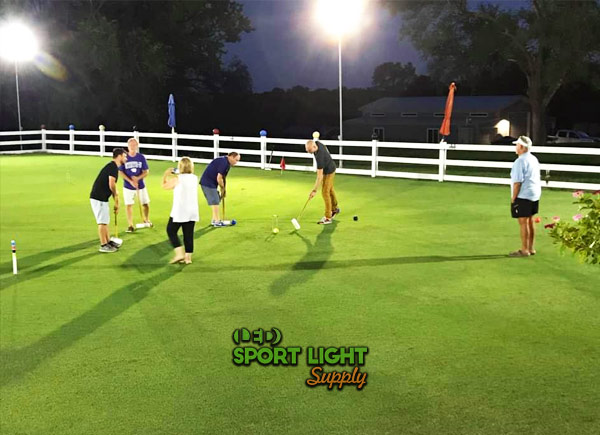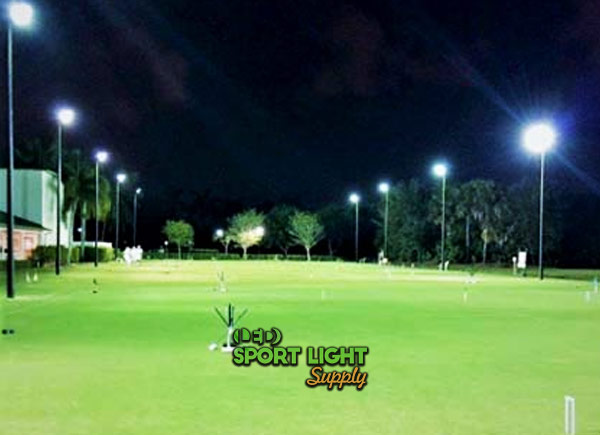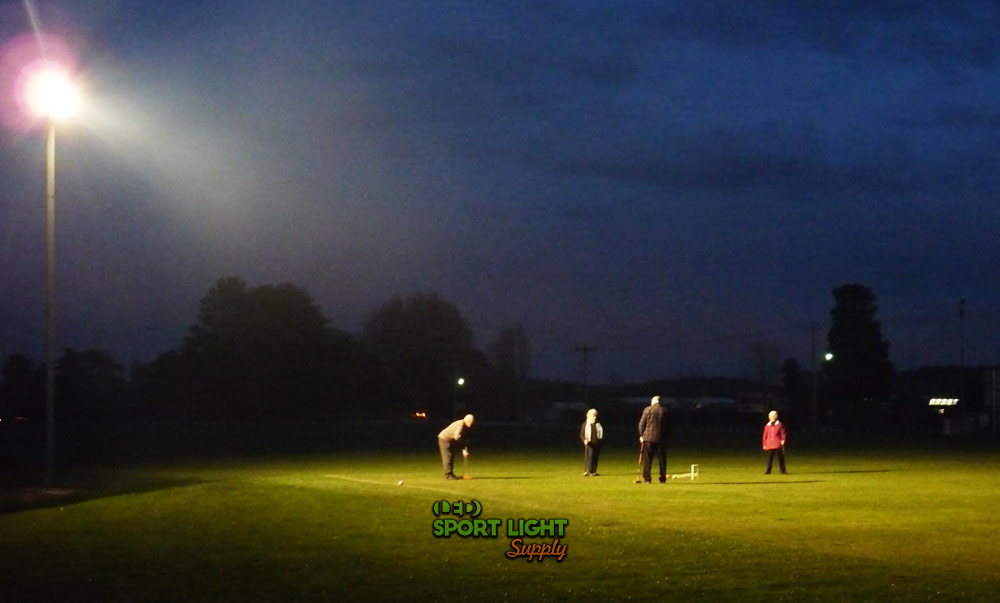Lighting designs for a croquet court vary depending on whether the court is used outdoors or indoors. For outdoor croquet courts, high-mast floodlighting is often used to ensure adequate illumination across the playing area. Conversely, indoor croquet courts typically require LED ceiling-mounted floodlights to provide sufficient lighting.
Illuminating a croquet pitch is generally straightforward, but adhering to specific guidelines and recommendations is crucial for optimal results. To assist with the setup phase, I have outlined essential ideas for both outdoor and indoor lighting designs. This guide will cover the fundamentals of getting started, highlight the benefits of proper lighting, and offer professional tips on incorporating solar lights to reduce electricity costs.
Table of Contents
ToggleLighting Options for Croquet Courts
Outdoor Croquet Court Lighting

Flood Lights
Flood lights are a common choice for outdoor croquet courts due to their ability to provide broad, even illumination. These lights come in various types, with LED flood lights being a modern, energy-efficient option compared to older models. LED flood lights consume less power and offer a longer lifespan, making them a popular choice among outdoor croquet enthusiasts. However, traditional flood lights are still in use and can be effective if properly maintained.
In a backyard setting, flood lights are essential for creating a well-lit environment. They are versatile, easy to install, and come in various models to suit different needs. For instance, security flood lights can be used to illuminate emergency exits, ensuring safety around the court.
Spot Lights
Spot lights are another useful lighting option for outdoor croquet courts. Unlike flood lights, spot lights emit a narrow beam of light, making them ideal for highlighting specific areas or long distances. This is particularly beneficial for courts that are exposed and lack surrounding light poles.
Multiple spot lights can be arranged to provide sufficient illumination and compensate for the absence of a traditional lighting system. Modern LED spot lights can be installed at high altitudes and controlled remotely, offering flexibility and durability. Many models come with pre-drilled, angled mounting brackets, facilitating installation in various locations.

High Mast Lights
High mast lighting involves using tall, industrial-grade poles to support large lighting fixtures. These poles, typically made of galvanized steel, are similar to those used in street lighting. For a croquet pitch, high mast lights can be configured with multiple single-arm towers or additional fixtures as needed.
High mast lighting systems consist of the pole, the fixture, and the foundation. Before installation, it’s crucial to ensure the ground is suitable for supporting the structure and to adhere to safety regulations. Reputable suppliers should offer comprehensive warranties for both the poles and fixtures.
Indoor Croquet Pitch Lighting
High Bay Lights
High bay lights are an excellent solution for illuminating indoor croquet courts. With a wide beam angle, these lights can cover the entire playing area effectively. Modern high bay lights come in various shapes, including rectangular and circular, and are designed to blend seamlessly with the venue’s decor.
LED high bay lights are particularly advantageous due to their adjustable brightness and energy efficiency. They are well-suited for tall ceilings and various pitch sizes. Installation options include mounting on brackets, hanging from the ceiling, or wiring into a dedicated structure.
Panel Lights
Panel lights, which feature a diffuser, offer soft and uniform lighting. This helps reduce glare and provides a more comfortable visual experience for players. Panel lights are especially useful for maintaining consistent light quality across the court.
These lights often come with advanced control systems and high-tech features, making them a flexible choice for various lighting designs. Available in multiple sizes, panel lights can be integrated into ceiling voids or suspended ceiling systems to meet different design requirements.

Getting Started with Croquet Court Lighting Layout
Number of Light Poles
When planning the lighting layout for a croquet court, the number of light poles required largely depends on the size of the field. High mast lighting can effectively manage the illumination needs, but the number of poles can vary. For smaller fields, placing four high masts at the corners is often sufficient. For larger layouts or more complex needs, additional poles may be needed—typically, six poles provide enhanced lighting. The arrangement usually involves three light poles on each side of the pitch, ensuring even coverage and minimizing shadows.
For high-profile events such as televised matches or tournaments, additional light poles may be necessary to achieve superior illumination. This setup not only improves visibility but also meets the lighting standards required for professional play.
Height of Croquet Field Light Poles
The height of the light poles is crucial and depends on the type of lighting being installed. Halogen lights, which tend to overheat significantly, should be installed on poles that are at least 10 meters tall to prevent safety hazards. Halogen lights can reach temperatures of up to 200°C (392°F), posing risks of overheating and potential fires.
In contrast, LED lights do not have a strict height limitation, though they should still be mounted at a height that ensures effective coverage of the field. Proper height placement ensures that the lighting is distributed evenly across the croquet lawn, enhancing visibility and playability.
Positioning of the Light Poles
Choosing the right positioning for the light poles is essential for optimal lighting conditions. Two primary options are available:
Side Lighting
Side lighting is ideal for outdoor fields that are situated between buildings or other structures. This method involves mounting croquet fixtures on existing street light poles or similar structures nearby. Side lighting effectively illuminates the playing area but may not be suitable for every setup.
Corner Lighting
Corner lighting is more traditional and commonly used for croquet facilities. By placing light poles at the corners of the court, this arrangement ensures that the entire field is well-lit from all angles. This setup is particularly beneficial for visibility, as it provides multiple light sources converging on the playing area. It ensures that wickets and the ball are visible from every position, enhancing the overall playing experience.
Distance Between Indoor Croquet Field Ceiling Lights
For indoor croquet courts, achieving uniform lighting is crucial for strategic play. The lights should be spaced at least 5 to 10 feet apart to ensure even coverage across the court. This spacing helps players see the entire croquet lawn clearly from any position, supporting strategic decisions such as executing block shots or passing through hoops.
Croquet Field Lighting Design
Lux (Footcandle) Requirement
The primary objective of a croquet field lighting design is to ensure that players and spectators can clearly see the colors of the balls. To achieve this, it’s crucial to measure and maintain appropriate brightness levels, which are typically quantified using lux or footcandles. A footcandle is equivalent to 10.76 lux, a standard unit for measuring brightness in the SI system.
Lux levels vary based on the level of play and the purpose of the lighting:
| Purpose | Lux Level |
|---|---|
| Recreational or General Use | 150 lux |
| Training | 300 lux |
| Competition | 500 to 700 lux |
These levels ensure that the lighting is adequate for different activities, from casual play to competitive matches.
Lighting Uniformity Standard
Achieving uniform lighting is essential for creating a professional and functional croquet field. The standard for lighting uniformity is typically between 0.5 and 0.7. To calculate this, measure the brightness at various points on the field and divide the minimum reading by the average or maximum value.
High lighting uniformity is important because it:
- Eliminates bright and dim spots, enhancing the field’s appearance
- Ensures that all obstacles on the lawn are visible
- Improves the overall sports experience
- Reduces eye strain for players
- Assists in determining whether a ball is within the yard line or out of bounds
CRI Standard
The Color Rendering Index (CRI) measures how accurately a light source reveals the true colors of objects. For croquet fields, a CRI value of 70 to 80 is recommended. This range ensures that the colors of the croquet balls are vivid and easily distinguishable, enhancing the players’ and spectators’ experience.
Color Temperature Recommendation
While there is no strict standard for color temperature, it is advisable to use warm white or cool white light. Cool white light is preferred for competitive play as it is less fatiguing for the eyes. If using LED lights, you may have the option to adjust the color temperature based on player preferences or specific game requirements.
Flicker-Free Lighting
For croquet fields, especially those used for social or televised events, flicker-free lighting is crucial. Standard LED lights can sometimes cause flickering, which can be problematic when recording videos or broadcasting matches. Flicker-free lights ensure that videos and broadcasts are clear and free from visual disturbances, providing a better experience for players and viewers alike.
Solar Lights for Backyard Croquet Court
Can We Use Solar Lights in a Croquet Court?
Yes, solar lights are a viable and eco-friendly option for lighting a croquet court. Solar lighting systems utilize photovoltaic panels to generate electricity from solar radiation, making them a sustainable choice. These lights come with built-in batteries to store energy and advanced sensors that optimize performance by automatically turning the lights on when natural daylight fades. Solar lights provide sufficient illumination for games that extend into the evening.
How Long Do Solar Flood Lights Last?
The lifespan of solar flood lights varies depending on the manufacturer and construction quality. On average, LED light sources in solar flood lights can last for many years. The battery life is influenced by the number of recharge cycles; the more frequently the battery is used, the shorter its overall lifespan due to wear and tear. Solar panels typically last around a decade. While solar flood lights are generally low-maintenance, periodic cleaning is recommended to maintain efficiency.
Pros and Cons of Using Solar Croquet Pitch Lights
| Pros | Cons |
|---|---|
| Zero installation cost | Solar panels may not charge effectively on cloudy days |
| Hassle-free use; no need for wiring or digging | Solar-powered lights may not support high-power flood lights (>1000W), limiting brightness to around 150 lux |
| Minimal maintenance required | |
| Wide variety of designs, including movable and foldable options | |
| Cost savings on electricity bills | |
| Versatile; can be repurposed as security lights or for other needs |
Benefits of Replacing Metal Halide, HPS, and Halogen Croquet Flood Lights with LEDs
Saving Maintenance Costs
Replacing old metal halide or HPS lamps with LED lights can significantly reduce future maintenance costs. LEDs offer greater reliability and durability, minimizing the need for frequent repairs or replacements. This ensures that the croquet court remains operational without delays, allowing you to fully enjoy uninterrupted games.
Saving Running Costs
LED lights are more energy-efficient compared to metal halide, HPS, and halogen lamps. They consume less power to achieve high levels of brightness, which translates to lower electricity costs over time. The longevity of LED lights also means fewer replacements and lower overall running costs.
Reducing Temperature
The temperature of the light source affects both the longevity of the light and the comfort of players. Halogen flood lights can generate excessive heat, potentially damaging the lawn and causing discomfort for players. In contrast, high-power LED lights are equipped with integrated heat sinks that efficiently dissipate heat. This reduces the risk of overheating and ensures a more comfortable playing environment.
Smartphone Control
LED lights offer advanced control options, including smartphone apps and Bluetooth functionalities. With systems like DMX lighting control and wireless remotes, you can easily adjust the brightness and power settings. Custom lighting profiles can be set for different events, such as official competitions or community gatherings. Expert lighting designers can provide tailored solutions to meet your specific needs.
Conclusion
Designing effective lighting for both outdoor and indoor croquet fields involves understanding various lighting options and their benefits. Whether opting for high mast floodlighting or spotlights for outdoor fields, or high bay and panel lights for indoor venues, careful consideration of lux levels, lighting uniformity, CRI, color temperature, and flicker-free features is essential.
For the best results, consider consulting with lighting experts to ensure your setup meets all requirements and to explore custom-made solutions. A lux meter can help assess the lighting needs, or you can hire a professional for a comprehensive evaluation and recommendation.
